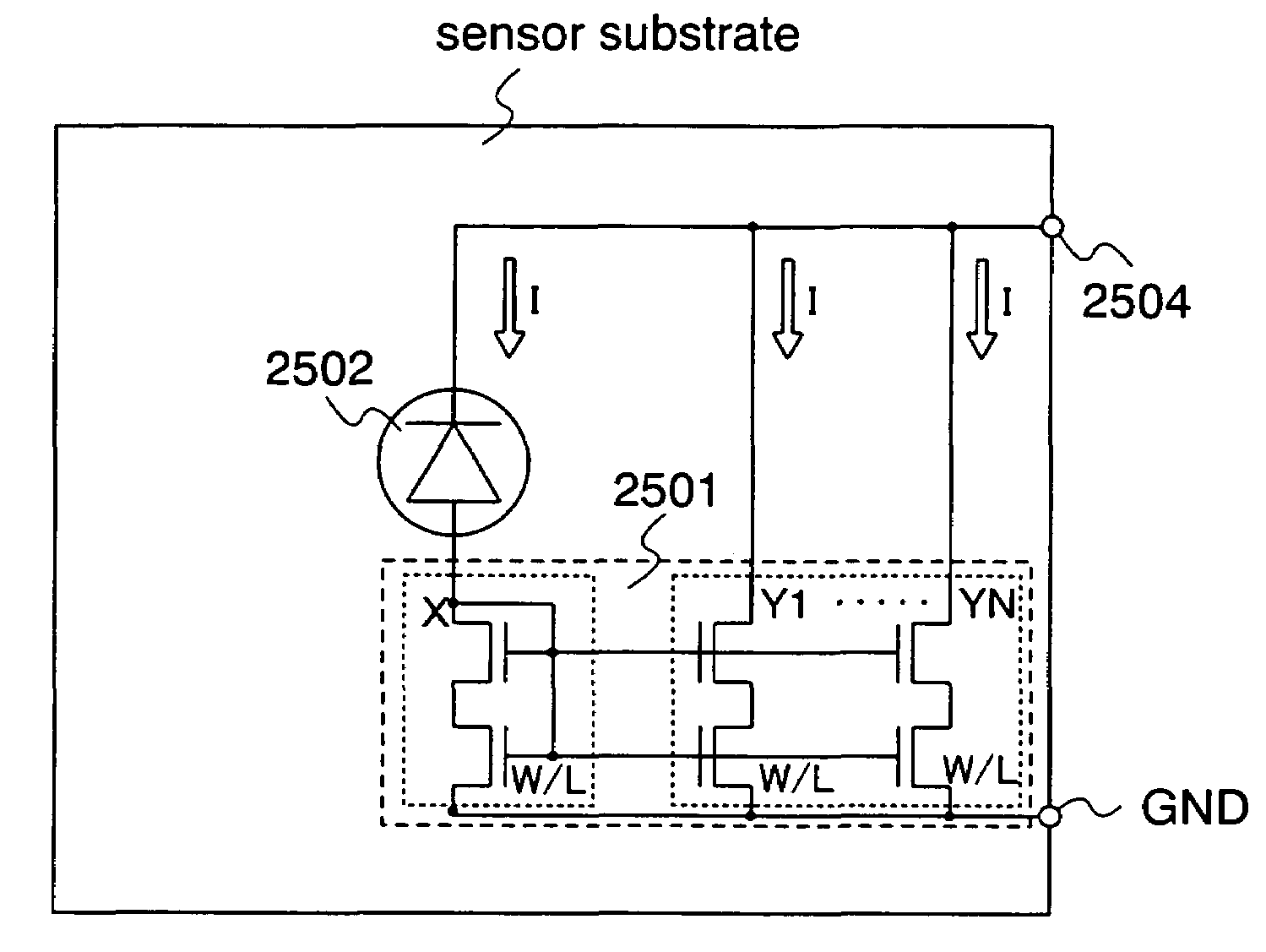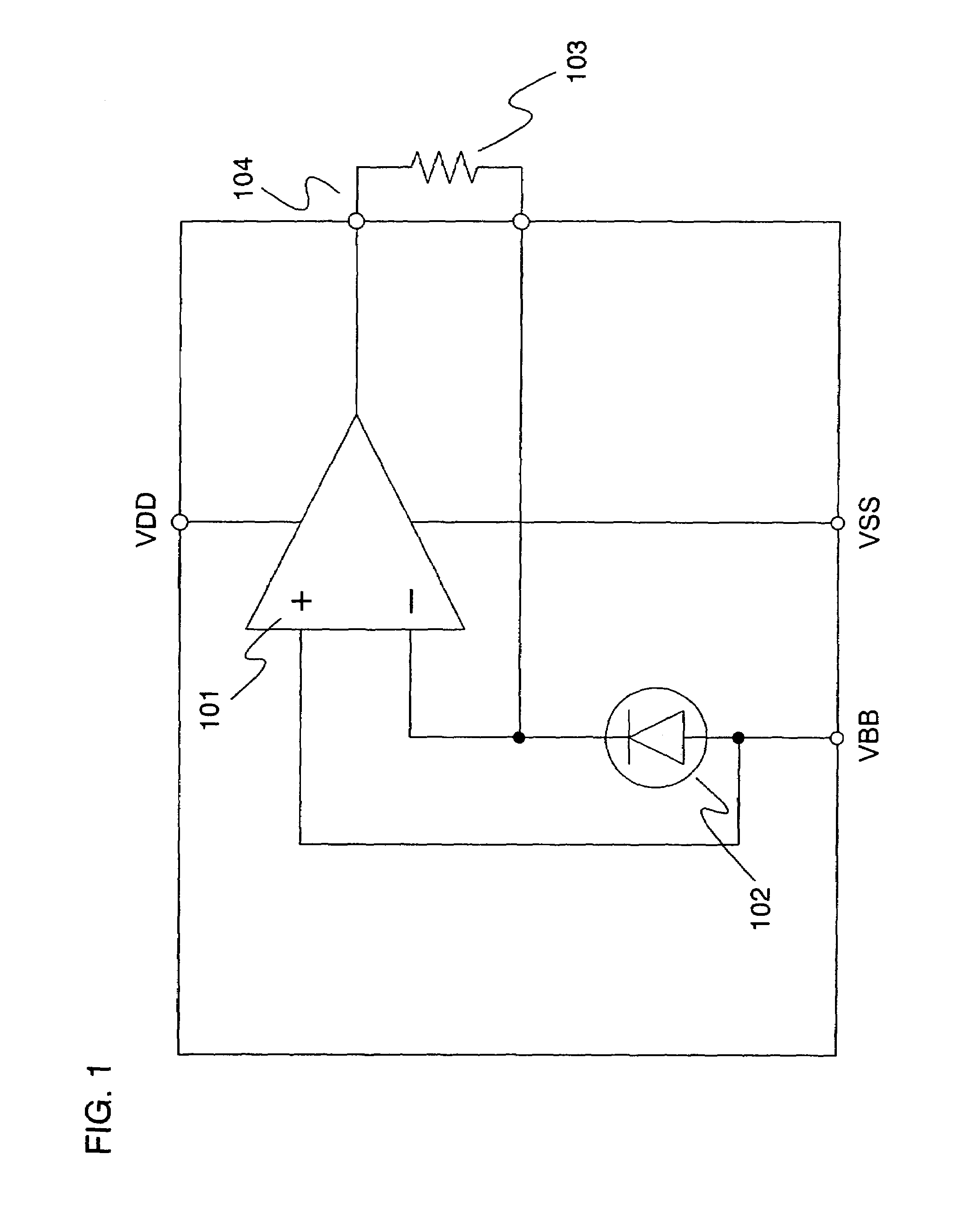Optical sensor device and electronic apparatus
a sensor device and electronic equipment technology, applied in the field of optical sensor devices, can solve the problems of large mounting space, high cost, and easy superimposed noise, and achieve the effect of reducing cost and mounting space, and reducing the noise of superimposed nois
- Summary
- Abstract
- Description
- Claims
- Application Information
AI Technical Summary
Benefits of technology
Problems solved by technology
Method used
Image
Examples
embodiment mode 1
[Embodiment Mode 1]
[0072]FIG. 1 shows the first embodiment mode of the invention. In this embodiment mode, an amplifier circuit 101 configured by a TFT and a photodiode 102 are formed integrally over a sensor substrate. An operation thereof is described below. A non-inverting input terminal of the amplifier circuit 101 is connected to an external power source VBB. The external power source VBB has a potential between a high-potential-side power source VDD and a low-potential-side power source VSS of the amplifier circuit 101. A first electrode of the photodiode 102 is connected to the external power source VBB and a second electrode thereof is connected to an inverting input terminal of the amplifier circuit 101 and a first terminal of a feedback resistor 103. A second terminal of the feedback resistor 103 is connected to an output terminal 104 of the amplifier circuit 101. Note that the feedback resistor 103 is formed outside of the sensor substrate in order to reduce the fluctuati...
embodiment mode 2
[Embodiment Mode 2]
[0078]FIG. 2 shows the second embodiment mode of the invention. In this embodiment mode, an amplifier circuit 201 configured by a TFT and a photodiode 202 are formed integrally over a sensor substrate. An operation thereof is described below. A non-inverting input terminal of the amplifier circuit 201 is connected to a first terminal of an I-V conversion resistor 203 and a second electrode of the photodiode 202. An output terminal 204 of the amplifier circuit 201 is connected to an inverting terminal thereof, that is, the amplifier circuit 201 is a voltage follower. A first electrode of the photodiode 202 is connected to an external power source VBB2. A second terminal of the I-V conversion resistor 203 is connected to an external power source VBB1. Note that the I-V conversion resistor 203 is formed outside of the sensor substrate in order to reduce the fluctuation of an output voltage, however, the I-V conversion resistor 203 may be formed over the sensor substr...
embodiment mode 3
[Embodiment Mode 3]
[0085]FIG. 3 shows the third embodiment mode of the invention. In this embodiment mode, an amplifier circuit 301 configured by a TFT, a photodiode 302, and level shift circuits 305 and 306 are formed integrally over a sensor substrate. An operation thereof is described below. An input of the level shift circuit 305 is connected to a low-potential-side power source VSS and an output thereof is connected to a non-inverting input terminal of the amplifier circuit 301. An input of the level shift circuit 306 is connected to a second electrode of the photodiode 302 and a first terminal of a feedback resistor 303 and an output thereof is connected to an inverting input terminal of the amplifier circuit 301. A second terminal of the feedback resistor 303 is connected to an output terminal 304 of the amplifier circuit 301. A first electrode of the photodiode 302 is connected to the low-potential-side power source VSS. Note that the feedback resistor 303 is formed outside ...
PUM
 Login to View More
Login to View More Abstract
Description
Claims
Application Information
 Login to View More
Login to View More - R&D
- Intellectual Property
- Life Sciences
- Materials
- Tech Scout
- Unparalleled Data Quality
- Higher Quality Content
- 60% Fewer Hallucinations
Browse by: Latest US Patents, China's latest patents, Technical Efficacy Thesaurus, Application Domain, Technology Topic, Popular Technical Reports.
© 2025 PatSnap. All rights reserved.Legal|Privacy policy|Modern Slavery Act Transparency Statement|Sitemap|About US| Contact US: help@patsnap.com



